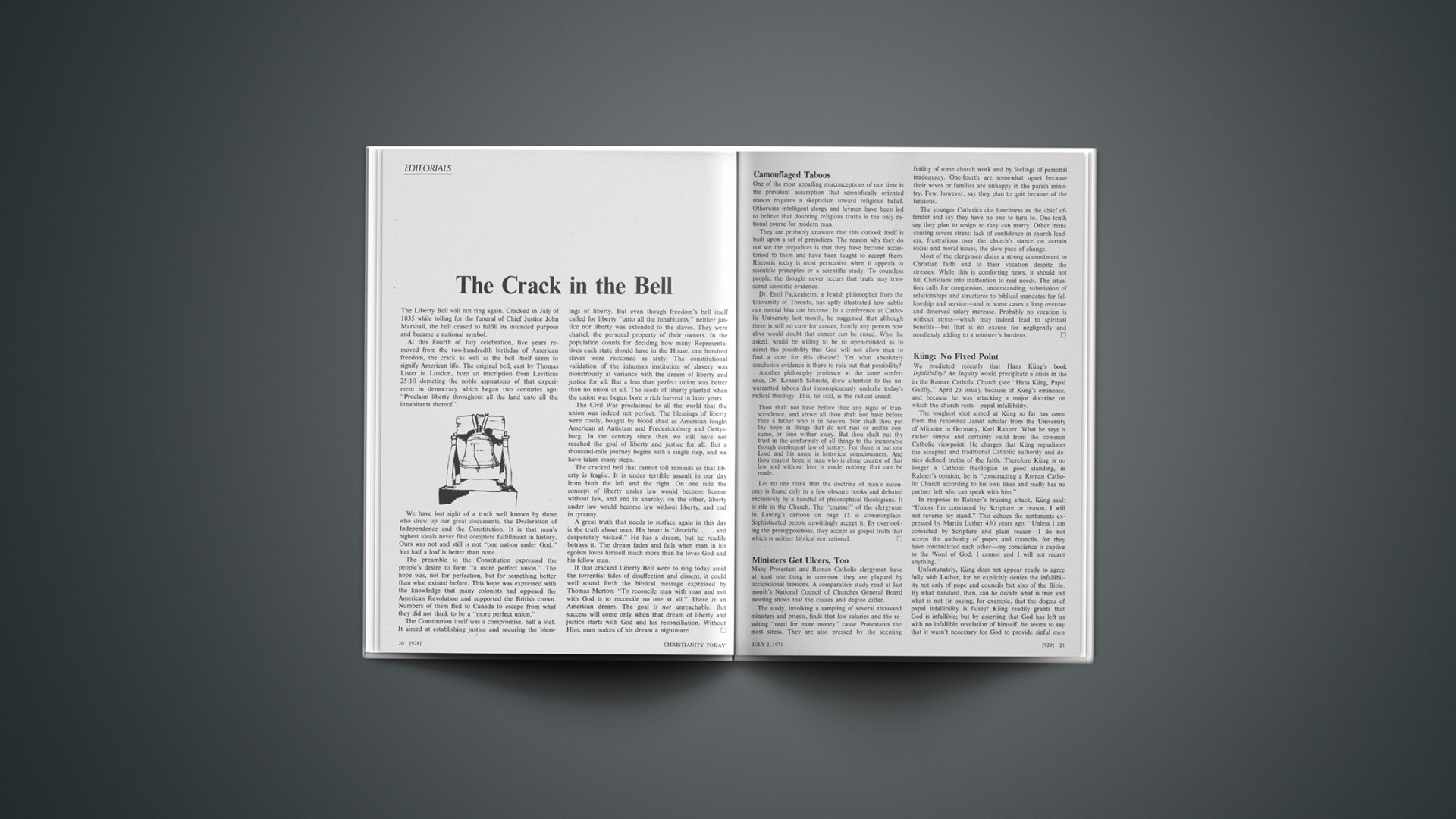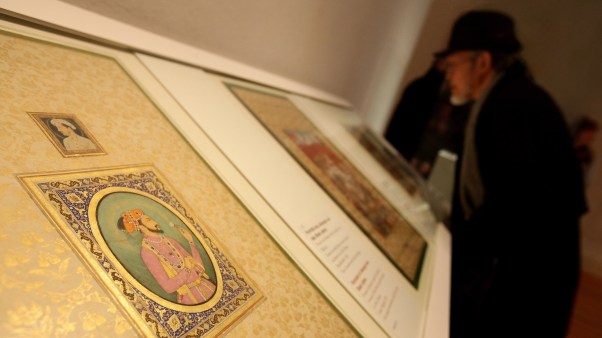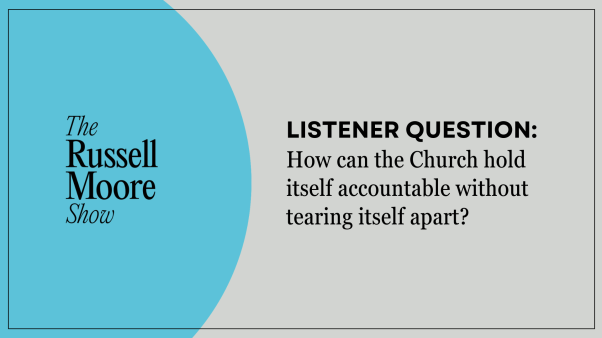EDITORIALS
The Liberty Bell will not ring again. Cracked in July of 1835 while tolling for the funeral of Chief Justice John Marshall, the bell ceased to fulfill its intended purpose and became a national symbol.
At this Fourth of July celebration, five years removed from the two-hundredth birthday of American freedom, the crack as well as the bell itself seem to signify American life. The original bell, cast by Thomas Lister in London, bore an inscription from Leviticus 25:10 depicting the noble aspirations of that experiment in democracy which began two centuries ago: “Proclaim liberty throughout all the land unto all the inhabitants thereof.”
We have lost sight of a truth well known by those who drew up our great documents, the Declaration of Independence and the Constitution. It is that man’s highest ideals never find complete fulfillment in history. Ours was not and still is not “one nation under God.” Yet half a loaf is better than none.
The preamble to the Constitution expressed the people’s desire to form “a more perfect union.” The hope was, not for perfection, but for something better than what existed before. This hope was expressed with the knowledge that many colonists had opposed the American Revolution and supported the British crown. Numbers of them fled to Canada to escape from what they did not think to be a “more perfect union.”
The Constitution itself was a compromise, half a loaf. It aimed at establishing justice and securing the blessings of liberty. But even though freedom’s bell itself called for liberty “unto all the inhabitants,” neither justice nor liberty was extended to the slaves. They were chattel, the personal property of their owners. In the population counts for deciding how many Representatives each state should have in the House, one hundred slaves were reckoned as sixty. The constitutional validation of the inhuman institution of slavery was monstrously at variance with the dream of liberty and justice for all. But a less than perfect union was better than no union at all. The seeds of liberty planted when the union was begun bore a rich harvest in later years.
The Civil War proclaimed to all the world that the union was indeed not perfect. The blessings of liberty were costly, bought by blood shed as American fought American at Antietam and Fredericksburg and Gettysburg. In the century since then we still have not reached the goal of liberty and justice for all. But a thousand-mile journey begins with a single step, and we have taken many steps.
The cracked bell that cannot toll reminds us that liberty is fragile. It is under terrible assault in our day from both the left and the right. On one side the concept of liberty under law would become license without law, and end in anarchy; on the other, liberty under law would become law without liberty, and end in tyranny.
A great truth that needs to surface again in this day is the truth about man. His heart is “deceitful … and desperately wicked.” He has a dream, but he readily betrays it. The dream fades and fails when man in his egoism loves himself much more than he loves God and his fellow man.
If that cracked Liberty Bell were to ring today amid the torrential tides of disaffection and dissent, it could well sound forth the biblical message expressed by Thomas Merton: “To reconcile man with man and not with God is to reconcile no one at all.” There is an American dream. The goal is not unreachable. But success will come only when that dream of liberty and justice starts with God and his reconciliation. Without Him, man makes of his dream a nightmare.
Camouflaged Taboos
One of the most appalling misconceptions of our time is the prevalent assumption that scientifically oriented reason requires a skepticism toward religious belief. Otherwise intelligent clergy and laymen have been led to believe that doubting religious truths is the only rational course for modern man.
They are probably unaware that this outlook itself is built upon a set of prejudices. The reason why they do not see the prejudices is that they have become accustomed to them and have been taught to accept them. Rhetoric today is most persuasive when it appeals to scientific principles or a scientific study. To countless people, the thought never occurs that truth may transcend scientific evidence.
Dr. Emil Fackenheim, a Jewish philosopher from the University of Toronto, has aptly illustrated how subtle our mental bias can become. In a conference at Catholic University last month, he suggested that although there is still no cure for cancer, hardly any person now alive would doubt that cancer can be cured. Who, he asked, would be willing to be so open-minded as to admit the possibility that God will not allow man to find a cure for this disease? Yet what absolutely conclusive evidence is there to rule out that possibility?
Another philosophy professor at the same conference, Dr. Kenneth Schmitz, drew attention to the unwarranted taboos that inconspicuously underlie today’s radical theology. This, he said, is the radical creed:
Thou shalt not have before thee any signs of transcendence, and above all thou shalt not have before thee a father who is in heaven. Nor shalt thou put thy hope in things that do not rust or moths consume, or time wither away. But thou shalt put thy trust in the conformity of all things to the inexorable though contingent law of history. For there is but one Lord and his name is historical consciousness. And thou mayest hope in man who is alone creator of that law and without him is made nothing that can be made.
Let no one think that the doctrine of man’s autonomy is found only in a few obscure books and debated exclusively by a handful of philosophical theologians. It is rife in the Church. The “counsel” of the clergyman in Lawing’s cartoon on page 15 is commonplace. Sophisticated people unwittingly accept it. By overlooking the presuppositions, they accept as gospel truth that which is neither biblical nor rational.
Ministers Get Ulcers, Too
Many Protestant and Roman Catholic clergymen have at least one thing in common: they are plagued by occupational tensions. A comparative study read at last month’s National Council of Churches General Board meeting shows that the causes and degree differ.
The study, involving a sampling of several thousand ministers and priests, finds that low salaries and the resulting “need for more money” cause Protestants the most stress. They are also pressed by the seeming futility of some church work and by feelings of personal inadequacy. One-fourth are somewhat upset because their wives or families are unhappy in the parish ministry. Few, however, say they plan to quit because of the tensions.
The younger Catholics cite loneliness as the chief offender and say they have no one to turn to. One-tenth say they plan to resign so they can marry. Other items causing severe stress: lack of confidence in church leaders, frustrations over the church’s stance on certain social and moral issues, the slow pace of change.
Most of the clergymen claim a strong commitment to Christian faith and to their vocation despite the stresses. While this is comforting news, it should not lull Christians into inattention to real needs. The situation calls for compassion, understanding, submission of relationships and structures to biblical mandates for fellowship and service—and in some cases a long overdue and deserved salary increase. Probably no vocation is without stress—which may indeed lead to spiritual benefits—but that is no excuse for negligently and needlessly adding to a minister’s burdens.
Küng: No Fixed Point
We predicted recently that Hans Küng’s book Infallibility? An Inquiry would precipitate a crisis in the in the Roman Catholic Church (see “Hans Küng, Papal Gadfly,” April 23 issue), because of Küng’s eminence, and because he was attacking a major doctrine on which the church rests—papal infallibility.
The toughest shot aimed at Küng so far has come from the renowned Jesuit scholar from the University of Münster in Germany, Karl Rahner. What he says is rather simple and certainly valid from the common Catholic viewpoint. He charges that Küng repudiates the accepted and traditional Catholic authority and denies defined truths of the faith. Therefore Küng is no longer a Catholic theologian in good standing, in Rahner’s opinion; he is “constructing a Roman Catholic Church according to his own likes and really has no partner left who can speak with him.”
In response to Rahner’s bruising attack, Küng said: “Unless I’m convinced by Scripture or reason, I will not reverse my stand.” This echoes the sentiments expressed by Martin Luther 450 years ago: “Unless I am convicted by Scripture and plain reason—I do not accept the authority of popes and councils, for they have contradicted each other—my conscience is captive to the Word of God, I cannot and I will not recant anything.”
Unfortunately, Küng does not appear ready to agree fully with Luther, for he explicitly denies the infallibility not only of pope and councils but also of the Bible. By what standard, then, can he decide what is true and what is not (in saying, for example, that the dogma of papal infallibility is false)? Küng readily grants that God is infallible; but by asserting that God has left us with no infallible revelation of himself, he seems to say that it wasn’t necessary for God to provide sinful men with a sure means of finding out the truths of redemption. He also seems to make every man (or every theologian) his own pope in deciding what is true or right. Indeed, Rahner has made the point that Küng simply assumes that Pope Paul’s teachings on birth control are wrong; how does Küng know they are?
By not affirming the infallibility of the Scriptures (derived from the infallibility of God himself, who supervised the production, compilation, and preservation of the Bible), Küng deprives himself of a fixed point of reference. He has to sit in judgment on Scripture, determine what to accept or reject, and build a theology on his own opinions.
When men make judgments on what is true and what is not, they in effect ascribe ultimate authority to their bases for such judgments. By denying authority to the Scriptures, as well as to the pope and the church, Küng in effect ascribes it to himself. We doubt that he really intends to do this and hope that in his theological pilgrimage he will arrive at the position of Luther: that the Word of God is the infallible authority.
Küng’s challenge is one of the most serious threats to Catholicism since the Reformation. Unless he recants, which is unlikely, he will surely not be able to stay in good standing in the church much longer. If he leaves or is forced out, the accompanying shock waves will rock the church for a long time to come.
On A Butterfly’S Wing
Man is a maker of symbols. To Christians the cross symbolizes hope at its greatest and reality at its sharpest. But modern man does not understand or believe in such hope, and another symbol, the butterfly, is gaining.
Since the early 1950s the butterfly has been appearing more and more frequently in novels, poems, and movies. Both Vladimir Nabokov and Saul Bellow use the butterfly as an important symbol. In Nabokov’s famous book Lolita, butterfly imagery abounds. Reality teases, and to pursue it with ferocity is often to lose it entirely, as in a butterfly chase. In 1968 the Swedish movie Elvira Madigan picked up Nabokov’s idea and used it as a central image. Elvira and her lover, Count Sixton Sparre, run off together. Throughout the movie Elvira chases butterflies, symbol of the elusiveness of her love. But as she catches one, Sparre shoots her and then himself. Modern man, too, is chasing butterflies of love, of happiness, of satisfaction; but just as he reaches out his hand to grasp it, his butterfly eludes capture and disappears.
The butterfly has fluttered out of book covers and film canisters to light on fabrics and posters and record jackets. It gets embroidered on blue jeans and enameled as jewelry. A hard rock band took for itself the oxymoronic name “Iron Butterfly.”
There is a paradox about this imagery. The butterfly suggests both the hope and hopelessness that is modern man’s soul. Just when a caterpillar relinquishes existence, a butterfly emerges from a sticky cocoon, turning ugliness into beauty. But this fragile beauty is short-lived and difficult to capture. It cannot be held or possessed; to do so is to bring it death. The solidity of calvinistic ownership—of truth as well as matter—is not a part of a butterfly world. Reality is elusive, hope is ephemeral; the absolutes are gone.
Man is trying to get and understand his soul, but is chasing it too hard and it is fleeing from him. Instead of believing in God, who wants man’s soul for good, he struggles for possession of his soul even as he sees it fly from him. That is modern man’s plight, the plight that the butterfly so aptly symbolizes.
Power To The People
The Apostle Paul has high hopes that Christians “will begin to understand how incredibly great [God’s] power is to help those who believe him. It is that same mighty power that raised Christ from the dead …” (Eph. 1:19, 20, Living New Testament). He says further that this “mighty power at work within us is able to do far more than we would ever dare to ask or even dream of—infinitely beyond our highest prayers, desires, thoughts, or hopes” (Eph. 3:20).
This power is resident in the Holy Spirit (Acts 1:8; 1 Pet. 3:18) and accompanies the spiritual ingestion of the Gospel: “The same Good News that came to you is going out all over the world and changing lives everywhere, just as it changed yours that very first day you heard it and understood about God’s great kindness to sinners” (Col. 1:6).
Many are experiencing this life-changing power as revival continues to spread in our day. One new teenage convert declared in a meeting at Greensburg, Kentucky, “I don’t know what has happened: I had some enemies at school; now I love them.” A mother in that town is awestruck by the changed attitudes in her two teen-age sons: “They show more concern and respect at home. They do their school work. They read the Bible together.”
God’s power is changing even the radicals. Thomas Miller, under indictment for riot activities at Kent State University a year ago, says, “Now that I have accepted Jesus and have been filled with his Holy Spirit, I will be going back to Kent to spread the word with anyone—young or old—who wants to listen.” We know of SDS and Weatherman activists who have similarly encountered the transforming power of God—as did a certain Saul of Tarsus centuries ago.
Churches too are coming alive to the power of God in new dimensions as Christians discover that the same power that holds the universe together can hold their lives together. The power that will someday put down sin and death forever can be unleashed in life and society today, for “God hath not given us the spirit of fear, but of power, and of love, and of a sound mind” (2 Tim. 1:7).
God has given power to his people as a resource for daily life and witness, and he has made it possible for anyone to plug into that power (Eph. 6:18).










